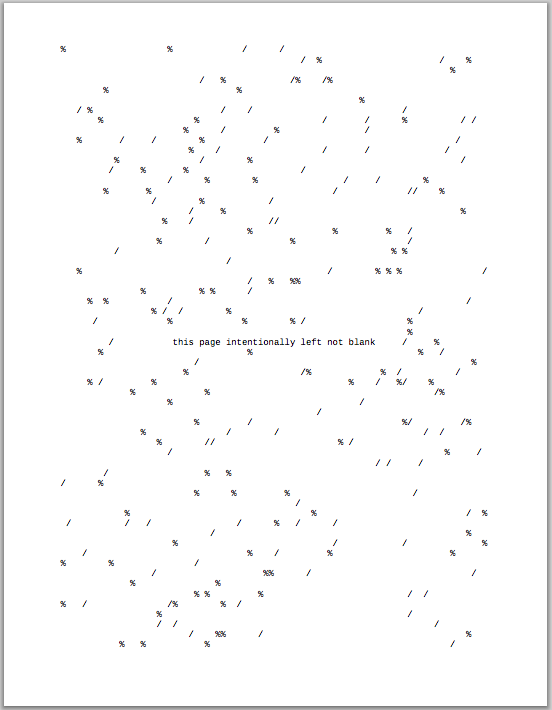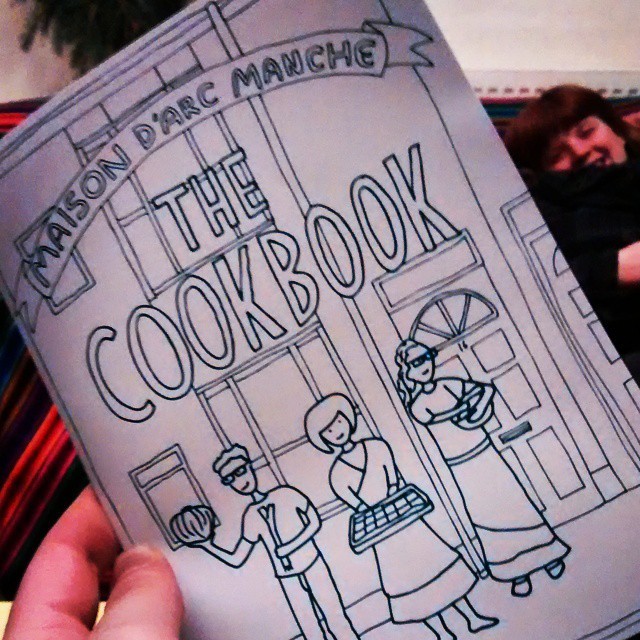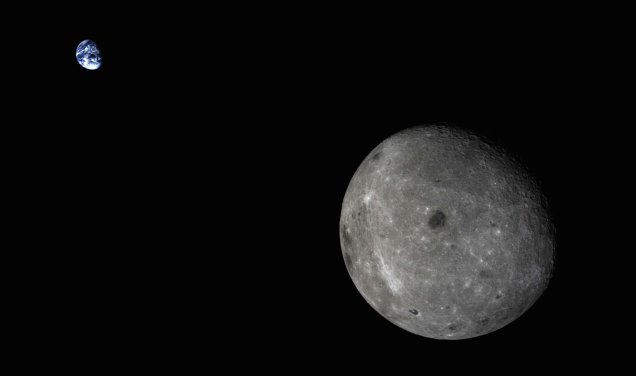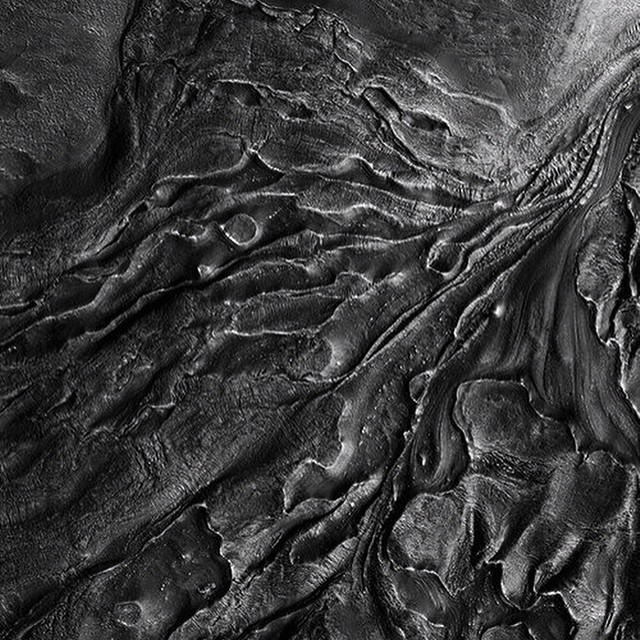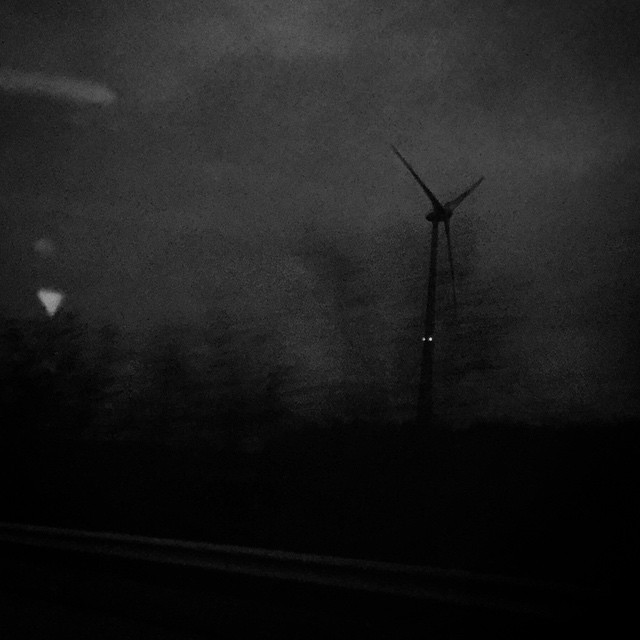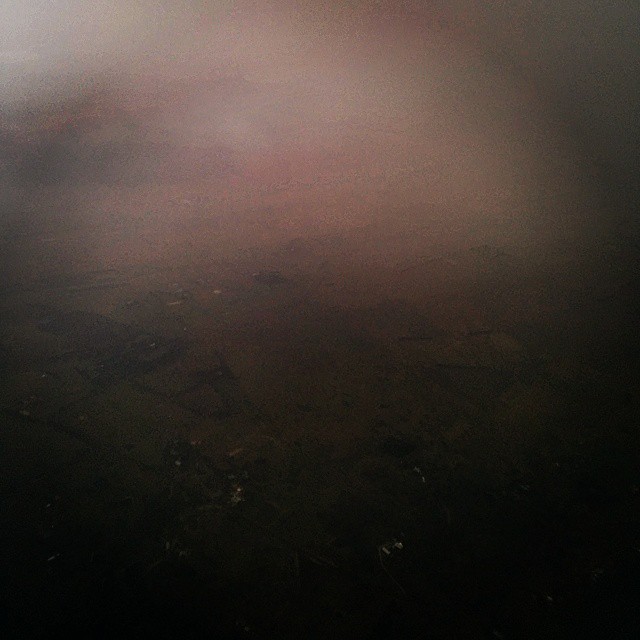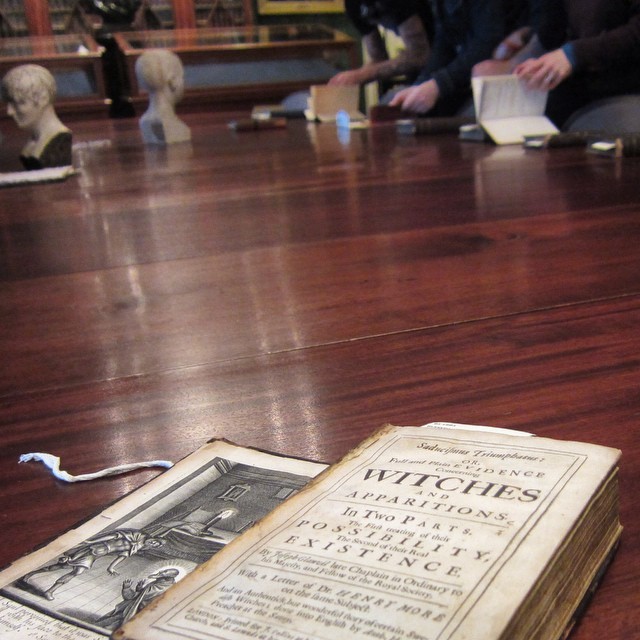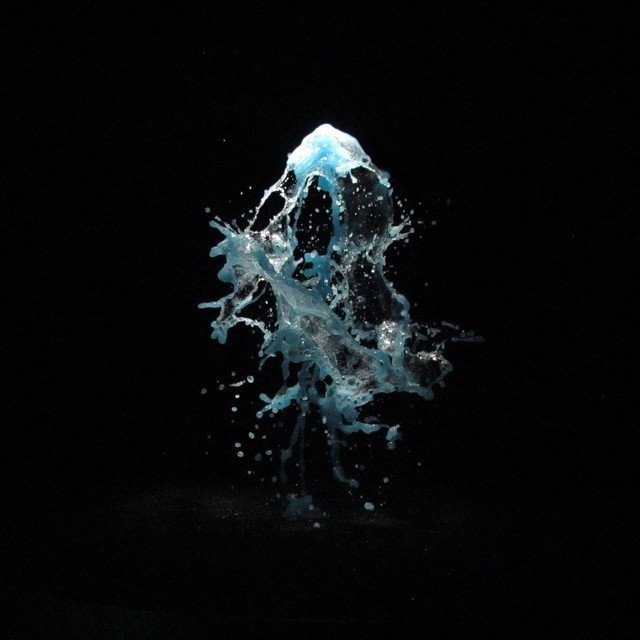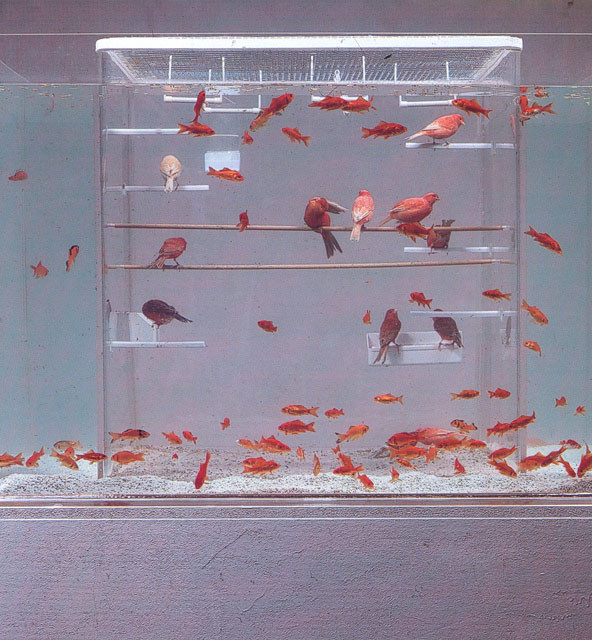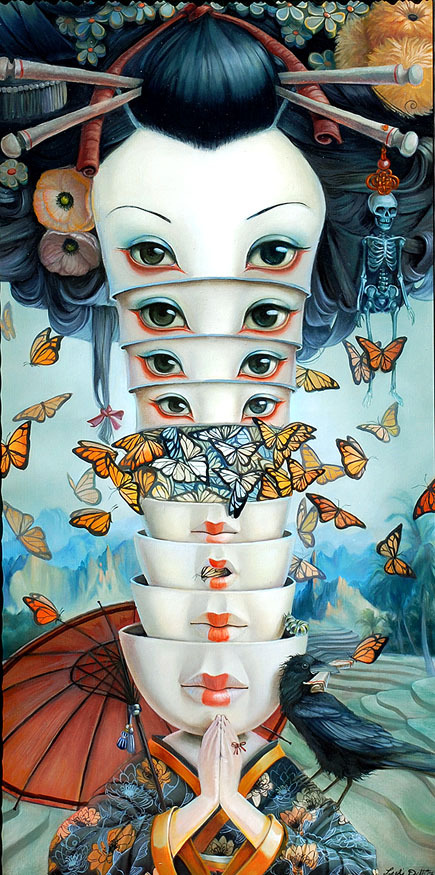bremser:
Google,
Stanley R. Mickelsen Safeguard Complex, Nekoma, North Dakota, October, 2012
This is what the missile site of the previous post looks like from the road. From the blueprints, the pyramid structure is about 75 feet / 23 meters tall (the structure continues below the berm). Cold War Tourist.com offers some photos of what the complex looks like inside recently. The very bottom of the page indicates the missile site was up for sale and, remarkably, was purchased by the Spring Creek Hutterite Colony (a group with some similarities to the Mennonites), for a sum of $530,000 USD. The government was generous enough to offer to pay for the extensive environmental cleanup. Click through the source to experience the drive-by, it’s a beautiful location, with the exhaust towers contrasting with the delicate windmills.
dezeen:
NASA wants to explore Venus with inflatable air-born “habitats” »
@ by Ania Klosek (via http://flic.kr/p/qsi6vU )
20141221 (via http://flic.kr/p/pxZQ2k )
20141222 (via http://flic.kr/p/qstwyE )
“In addition to the original logistics system, the newly “Yi-Xin-Ou” is the first international logistics railway channel from Yiwu to Europe. On Dec. 9, “Yi-Xin-Ou” traveled for three weeks and 13,000 kilometers and arrived at Madrid. Passing through eight countries including Russia, Belarus, Ukraine, Poland and Germany, the train from Yiwu delivered this year’s Christmas gifts from China.”
–E-commerce Brightens Christmas Trees from Yiwu, China — YIWU, China, Dec. 16, 2014 /PRNewswire/ — (viaiamdanw)
“
“It would be difficult for any importer if their purchase cannot fill one container. Even if the sellers are OK to sell you a half-container of products, you still need to pay for the shipping cost for the half-empty container, which would drive up the cost of importers,” he says.
But in the Yiwu market, people can easily select and pick up hundreds of different products, put them in one container and ship them back to their home countries together, according to Jin.
Selling less than container loads is increasingly popular in Yiwu as importers are not confident about selling a large amount of products when their countries have been hit by an economic slowdown.
The situation actually boosts Yiwu’s business because the market sells close to 2 million different types of small commodities, says Chang Xiaolei, CEO of Master Base International E-Commerce Co Ltd, an Australian trade agent.
“The business model of Yiwu fits the demand of Australian importers very well because it is a country with a small population. Many of the importers cannot buy a container of one type of products,” says Chang, whose company has been offering trade services to Australian importers in Yiwu for 20 years.
”
–E-commerce brings new business to China Commodities City|Cover Story|chinadaily.com.cn (viaiamdanw)
invisiblestories:
Richard McGuire, Here
mon-lieu:
Moebius - Metamorfosi (da Il Fallico Folle)
“Across the experiences of Rosetta, Philae, Orion, Wanderers, Ambition, and Interstellar, we can start to see a reconfiguring of public expectations around space science and technology. Our understanding of space remained relatively static for the duration of the twentieth century; it was a site for exploration and the demonstration of engineering prowess, a source of wonder, a new frontier. We have always been only a few decades away from the first manned Mars mission.”
–STRANGE TELEMETRY Objects in Space (viaiamdanw)
adamgoldberg:
this evening.
20141220 (via http://flic.kr/p/qbPVX3 )
20141219 (via http://flic.kr/p/qr6DEJ )
20141218 (via http://flic.kr/p/qr6Cco )
20141217 (via http://flic.kr/p/qtjaZw )
20141216 (via http://flic.kr/p/qr6z8C )
daraartisans:
ART THAT INSPIRES Shi Jinsong
“I just want to know what a big tree with a speed of more than 100 km per hour looks like."
Photographed by Jason Florio.
jakestollery:
Oracle, 3D Printed Mask Design.Photograph by Tomasz Machnik Photography. Mask and Photography, Exhibited at He Made She Made, Sydney.
“Tsur’s larger argument is that fictional narratives affect us by delaying or disrupting “in some other manner” our cognitive processes. Moreover, our awareness of those disruptions “indicates to consciousness” that our crucial cognitive adaptations are in good shape (always welcome news).”
–
Zunshine, Lisa.
Why We Read Fiction: Theory of Mind and the Novel. Columbus, Ohio: Ohio State University Press, 2006. 2012. (viacarvalhais)
futureproofdesigns:
Concubine, Black and White Photograph of Concept Model
Peter Macapia
2009
vansmirren:
P470 -2014-
_MG_3370 by ]ezra[ (via http://flic.kr/p/pvwJnb )
Produce -13039 by Poetic Medium (via http://flic.kr/p/qsHPnX )
Sun Release M8.7-Class Solar Flare on Dec. 17, 2014 by NASA Goddard Photo and Video (via http://flic.kr/p/qrKaYe )
“In this respect, and despite its small population – a little over 2 million – and complete absence from any travel guide or tour package, Yiwu possesses a remarkable international character. More than that, Yiwu leads us to a different conception of “globalization” in today’s China. Unlike, for instance, Beijing’s Sanlitun or Shanghai’s Pudong, the Mayide area in Yiwu narrates a different tale of modernity and globalization, one maybe less known but by no means less real or important. Foreigners in Yiwu seem to prefer a shalwar kameez over a suit, and enjoy some apple-shisha tobacco rather than an imported French wine. Inside the various restaurants, televisions broadcast Bollywood movies, cricket games and news in Urdu, Turkish, Arabic, and Russian. As I, in the neon lights of the Mayide, felt often bewildered, most people seem to be feeling home. Modernity, I told myself, occurs in many different ways, and Yiwu most definitely offers a glimpse of something alternative from the version that we too often take for granted.”
–China Policy Institute Blog » Alternative modernities and international trade in China (viaiamdanw)
“The presence of methane is significant because the gas cannot exist for long. Calculations indicate that sunlight and chemical reactions in the Martian atmosphere would break up the molecules within a few hundred years, so any methane there now must have been created recently. It could have been created by a geological process known as serpentinization, which requires both heat and liquid water. Or it could be a product of life in the form of microbes known as methanogens, which release methane as a waste product.”
–‘A Great Moment’: Rover Finds Clue That Mars May Harbor Life - NYTimes.com (viaiamdanw)
micdotcom:
NASA just found strong evidence of life on Mars
On Tuesday, NASA announced that its one-ton Curiosity rover made a surprising discovery on Mars: “burps” of organic methane gas that very well may be evidence of living microbes beneath the planet’s surface.
Cookbook D'Arc Manche. (via http://instagram.com/p/wrWmFxCaTA/)
An employee of the Russian Space Training Center near Noginsk, Russia, hung the space suits of Russia’s Anatoly Ivanishin, NASA flight engineer Kathleen Rubins, and Takuya Onishi of Japan after their training on July 2. Alexander Zemlianichenko/Associated Press
“Baron-Cohen points out that “attributing mental states to a complex system (such as a human being) is by far the easiest way of understanding it,” that is, of “coming up with an explanation of the complex system’s behavior Thus our tendency to interpret and predicting what it will do next.””
–
Zunshine, Lisa.
Why We Read Fiction: Theory of Mind and the Novel. Columbus, Ohio: Ohio State University Press, 2006. 2012. (viacarvalhais)
brucesterling:
*In other words, disruption’s all about the benefits for poor guys. I wonder if Marc ever says this stuff privately to his fellow rich guys while keeping a straight face.
struanteague:
Untitled, acrylic, spray paint, graphite and screenprint on wood, framed, 42 x 40 cm
thenewinquiry:

By Sarah Black McCulloch
Immune systems don’t make for clean narratives, even as we expect them to keep us pure.

Spinoza said: we don’t know what a body can do. The question of a body’s power [pouvoir] pushes aside another question that we tend to ask right away: the…
Host in the Shell
20141215 (via http://flic.kr/p/q9BGyA )
20141214 (via http://flic.kr/p/qrash4 )
20141213 (via http://flic.kr/p/q9BBgb )
20141212 (via http://flic.kr/p/pub6bU )
complet.JPG by znrR (via http://flic.kr/p/4nfLSK )
10042009605.jpg by znrR (via http://flic.kr/p/6CxxBL )
by futile81 (via http://flic.kr/p/k9RYG4 )
by futile81 (via http://flic.kr/p/qhMYML )
Black Spirits by Narkiss_A (via http://flic.kr/p/ptNjyi )
A wrecked ship by sungsooleephoto.com (via http://flic.kr/p/qqtQuY )
by luci d'inverno (via http://flic.kr/p/qqcW7G )
Geoid 2011 - Potsdam Gravity Potato
“
From 7–8pm on Friday, software used by third-party sellers to ensure their products are the cheapest on the market went a bit haywire and reduced prices to as little as 1p. “Amazon is all kinds of broken,” one observer tweeted. “Mattress 1p. Heaphones 1p. Batteries, clothing, games all 1p. Someone messed up big time.”
Martin Le Corre, who sells toys and games via his MB Homewares store on Amazon, told the Guardian that the glitch in software developed by RepricerExpress could have cost him more than £100,000.
“We got a call from a competitor to say ‘do you realise all your listings at a penny?’ By the end of the hour, we had 1,600 orders,” he said. “People were buying 10, 50, 100 copies of everything. It is £50,000, £60,000, £100,000 of stock; we can’t even work it out.”
Le Corre immediately took his store offline, but more than £30,000 worth of orders had already been marked as dispatched by Amazon. Orders that have already been dispatched cannot be cancelled and shoppers will be able to keep the goods.
”
–Amazon sellers hit by nightmare before Christmas as glitch cuts prices to 1p (viaiamdanw)
#lightjerkx (via http://instagram.com/p/wobaCoDL8i/)
SORN/Image: Impressive Photographs from Mars’ surface taken by the Mars Reconnaissance Orbiter #mars #photography #space #surface (via http://instagram.com/p/wokYfUQ1tw/)
homeward bound (via http://instagram.com/p/wo21K-iWrH/)
In to the murk (via http://instagram.com/p/wpD1cwp7Oa/)
bye. by lars on mars (via http://flic.kr/p/q8WE6s )
2001_102 by Pierre Wayser (via http://flic.kr/p/7t8GuS )
saturday. by (x)99. (via http://flic.kr/p/psGHE7 )
by Strange birds (via http://flic.kr/p/qpUw3U )
Mt Whitney by Peter de Graaff (via http://flic.kr/p/qqefM8 )
The magnetic field along the Galactic plane by europeanspaceagency (via http://flic.kr/p/ptweY8 )
Onion - 1809 by Poetic Medium (via http://flic.kr/p/qqjUUa )
Fino allo schianto. by plochingen (via http://flic.kr/p/qo588b )
Exploring rare books on witchcraft, mesmerism, and the occult today at Philadelphia’s Athenaeum. Thanks to all who joined & to @susurrusdin for leading our adventure! #atlasobscura #philadelphia #witches #rarebooks #athenaeum #library (via http://instagram.com/p/wklxE8KfT1/)
detail, #aptwth 3 - #america - earlier this year - (via http://instagram.com/p/wn-yd3QS7O/)
The astounding, strobing #BigBangFountain by #OlafurEliasson at his new show #Contact in Paris. “Extending the eye towards a horizon of things we shouldn’t be able to see”. #fondationlv (via http://instagram.com/p/woXd5Mi-lE/)
wowgreat:
Alberto Cuteri
#9 by Colourful Life (Teresa) (via http://flic.kr/p/q8655D )
Morning press by David V. Kutaliya (via http://flic.kr/p/oXboWW )
Paris by David V. Kutaliya (via http://flic.kr/p/p2i4Rn )
_MG_8424 by Pierre Wayser (via http://flic.kr/p/9tdmrH )
by 美撒郭 (via http://flic.kr/p/ps9Rva )
sickpage:
robert gligorov
arinewman7:
Leslie Ditto~
The Belgacom hack, he said, is the “first documented example to show one EU member state mounting a cyber attack on another…a breathtaking example of the scale of the state-sponsored hacking problem.” Publicly, Belgacom has played down the extent of the compromise, insisting that only its internal systems were breached and that customers’ data was never found to have been at risk. But secret GCHQ documents show the agency gained access far beyond Belgacom’s internal employee computers and was able to grab encrypted and unencrypted streams of private communications handled by the company.
https://firstlook.org/theintercept/2014/12/13/belgacom-hack-gchq-inside-story/
20141211 (via http://flic.kr/p/qoprSU )
20141210 (via http://flic.kr/p/qosXVg )
20141209 (via http://flic.kr/p/q6Vesy )
20141208 (via http://flic.kr/p/prtGT9 )
20141207 (via http://flic.kr/p/q73Unv )
20141206 (via http://flic.kr/p/prHaY4 )
831_0455.jpg (via http://flic.kr/p/qonCWG )
91156_ImageNoiseGrid_str_4_2 by HolgerLippmann (work in process) (via http://flic.kr/p/qm1ktJ )
message deleted by lars on mars (via http://flic.kr/p/poeaBY )
spaceship has landed by lars on mars (via http://flic.kr/p/qkambu )
lost land autopsy by lars on mars (via http://flic.kr/p/q4neL4 )
South Kalimantan, Borneo by europeanspaceagency (via http://flic.kr/p/q6KbRD )
QITITTUT - DANCING ANCESTORS. © 2012 Stella Polaris* Ulloriarsuaq/Sven Nieder by leica_camera (via http://flic.kr/p/q6S78B )





